Column
2023年10月11日
Gaia Vision’s vision and current initiatives (from the Nikkei Super DX/SUM 2023 pitch)
This article introduces the vision that Gaia Vision aims for, the current initiatives, and prospects, as presented in the pitch at the Nikkei Super DX/SUM 2023 held in September 2023.
Gaia Vision’s vision: Corporate and local governments working together to promote flood risk assessment and countermeasures (“river basin TCFD”).
Recently, major flood disasters have been occurring one after another. For example, there was a torrential rainstorm in western Japan in 2018 (total flood damage: JPY 1.405 trillion; Source: MLIT), and in 2019 there was another torrential rainstorm in eastern Japan (total flood damage: JPY 1.86 trillion; Source: MLIT). With climate change expected to cause more severe disasters in the future, society needs to increase its resilience against natural disasters. We believe it is necessary to establish a management cycle in which companies and public organizations conduct risk assessments considering future climate change and take appropriate countermeasures, as well as individual measures such as levees.
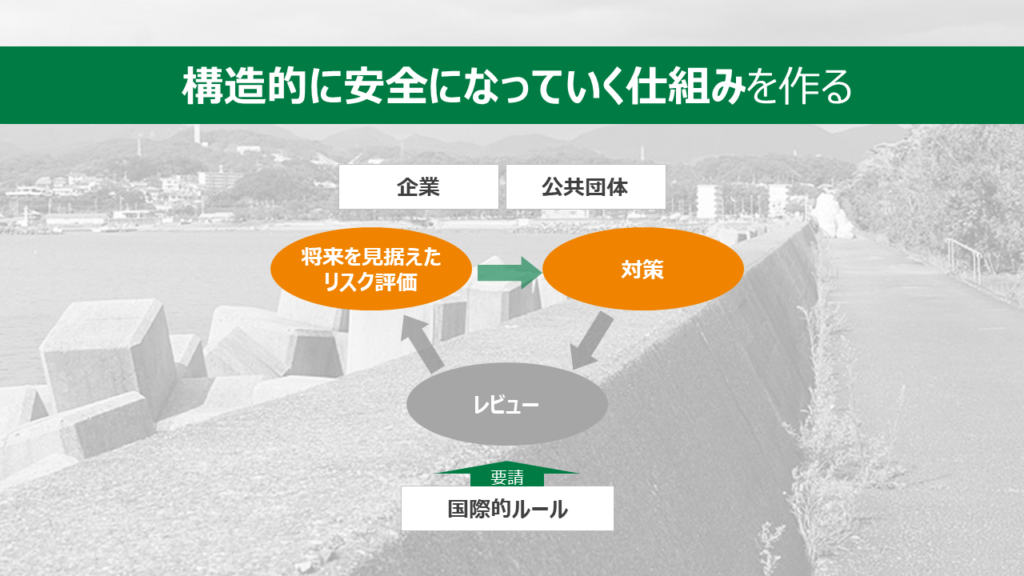
International rules (and initiatives) such as the CDP and TCFD/ISSB require companies around the world to manage climate change risks autonomously. On the other hand, even though international rules are becoming structured, there have not yet been efforts on quantitative assessment of disaster risks and concrete measures to address them. This is because it is difficult to assess flood risks, including the impact of future climate change, and specific measures that one company can take are limited.
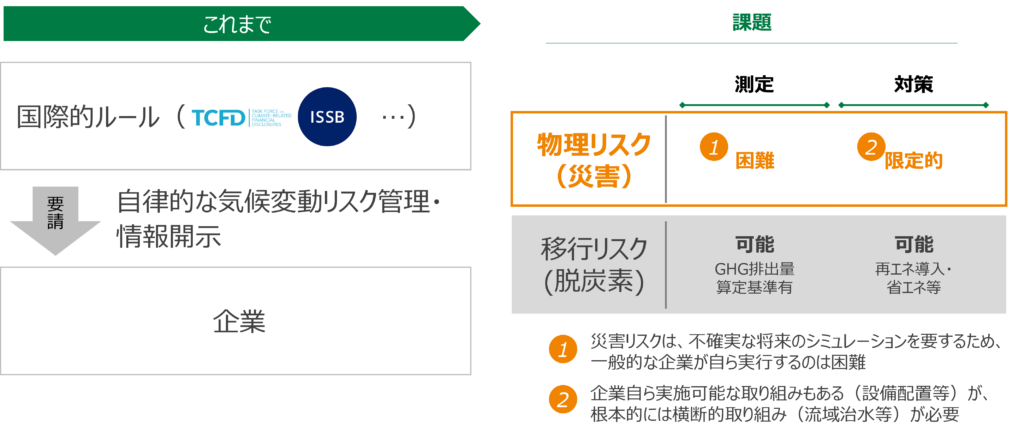
We believe that,
- A system that enables a high-resolution disaster risk assessment in consideration of climate change [Risk Assessment].
- A system that can forecast and detect risks in real time [Risk Detection].
- リスク評価の結果を踏まえ、適切な対策につなげる仕組み【リスク軽減】
- Measures by the company
- Connect to measures by the public sector (based on the risk information from companies)
≈ “River basin TCFD”
all three of the above should be implemented in society and the management cycle be encouraged by international rules.
From a flood control perspective, it is important to have “river basin flood control” in which multiple stakeholders from upstream to downstream of a river basin work together, rather than on a company-by-company or individual municipality basis. It is important to apply company-level risk assessments conducted through TCFD, and this concept is called “river basin TCFD”. It is to collect opinions and risk information (information on expected damage) of companies, who are the recipients of flood risks, and to assess the risks at the regional/basin level together with the risks of the general public, which leads to taking appropriate countermeasures.
Reference) Use of Global Flood Models for Climate-related Risk Disclosure and Its Potential Application to River Basin Management, Dai Yamazaki *1 and Yukiko Hirabayashi*2, Kasen 2023 (*1: Associate Professor, Institute of Industrial Science, The University of Tokyo; *2: Professor, Department of Civil Engineering, Shibaura Institute of Technology)
Gaia Vision’s Solution 1 Climate Vision, a climate change risk analysis platform that was introduced in MLIT’s publication
As a solution corresponding to 1., Gaia Vision offers Climate Vision, a climate change risk analysis platform. This is a platform that allows for easy quantitative assessment of flood risk by simply entering addresses and other location information. The advantage over conventional solutions such as MLIT’s hazard maps is that it is globally applicable and usable under future climate change simulations. Climate Vision can be used to quantitatively understand the flood risk of a company’s portfolio and for sustainability information disclosures / future climate scenario analysis, such as CDP and TCFD, internal disaster management studies, BCP studies, and internal consensus building. Climate Vision is also introduced as an example product for future flood hazard maps in the “Guidance for Physical Risk Assessment in TCFD Recommendations” released by MLIT in March 2023. In fact, many examples of risk analysis and information disclosure using Climate Vision are emerging, mainly in the manufacturing industry, such as NEC Corporation and Sakata Inx Corporation. We aim to leverage these examples to make Climate Vision one of the international standard tools.
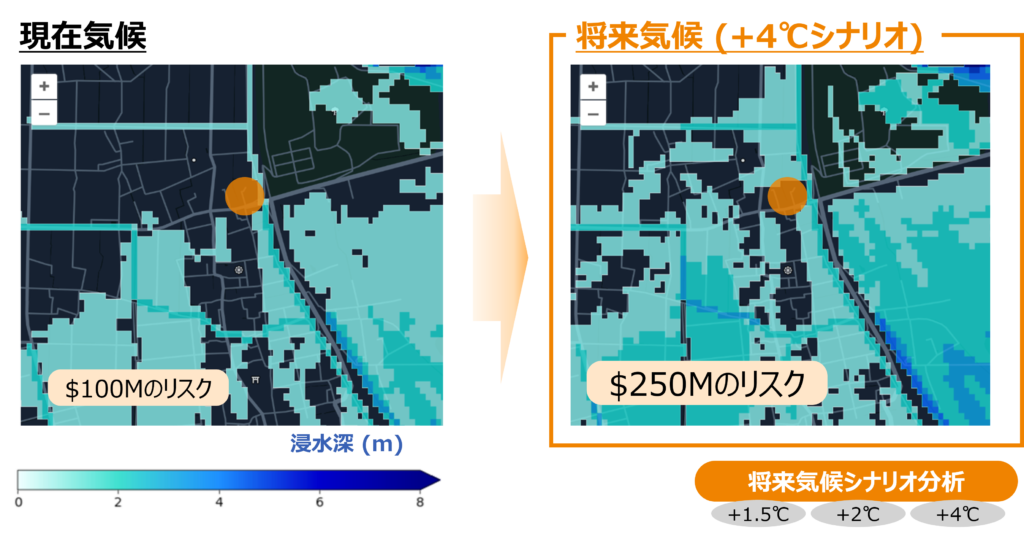
■Gaia Vision’s Solution 2 Real-time flood forecast solutions
We aim to develop real-time flood forecast solutions as well as long-term assessments of flood risk. While local governments need to provide appropriate evacuation guidance in the event of flooding, such decisions are not always based on quantitative judgments, and many local governments are facing challenges in providing appropriate and timely evacuation instructions. Companies such as manufacturing and infrastructure companies also feel the need for appropriate and timely pre-emptive measures.
When our solution is realized, it will be possible to predict flood inundation for each location with high accuracy about 1.5 days in advance. This is expected to lead to more effective evacuation guidance, such as the ability to send customized messages to small, identified groups of people, rather than broad evacuation orders. Currently, the prototype has been completed, and we are beginning to provide information to municipalities and companies that are potential users of the system.
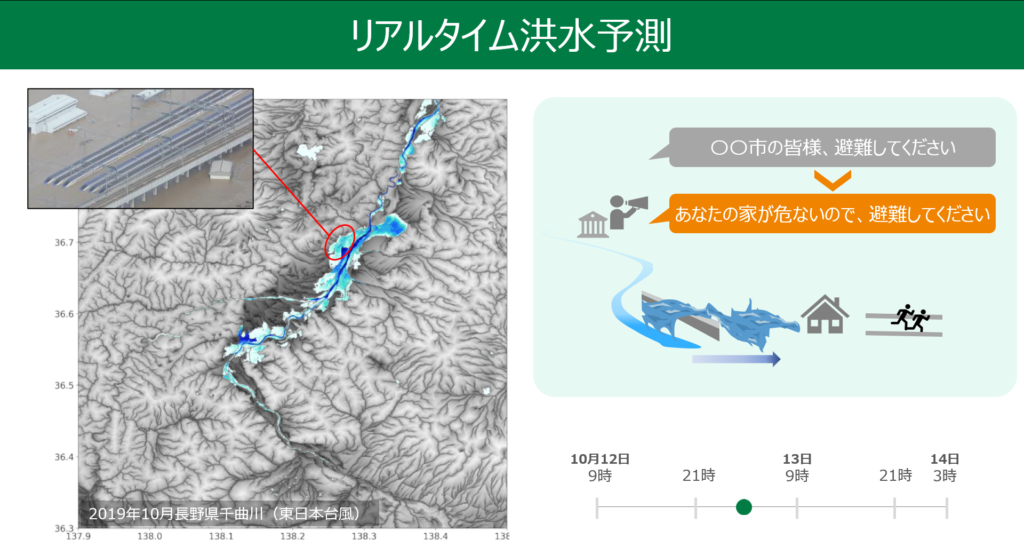
Reference: Simulation video
Gaia Vision’s Solution 3 Flood Control Project Study Support Tool
In relation to the river basin TCFD, we are also developing tools to assist in the study of flood control projects, such as how much damage can be reduced when levees are constructed or enhanced. Some people mention that they think disaster risk management is necessary, but it is difficult to secure the budget for something that may or may not happen. In this context, we aim to evaluate the investment return of flood control projects by including the damage suffered by companies, and thereby support the promotion of appropriate flood control projects. We are also working on estimating river flows, which is important for dam planning and operation. The deployment of the climate change risk analysis platform Climate Vision and the real-time flood forecasting solution for local governments will accelerate the promotion of flood control projects by, for example, making it possible to correctly estimate the expected damage to company-owned assets. Currently, we have created a prototype of this platform and have begun to introduce it to customers.
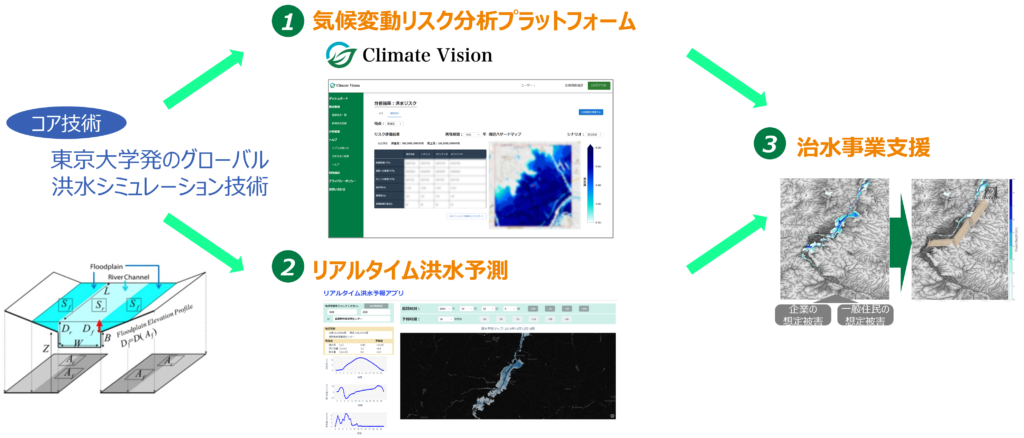
■Future prospect
We will increasingly promote the deployment and functional expansion of the climate change risk analysis platform “Climate Vision”, as well as the demonstration and social implementation of real-time flood forecasting and flood control project support.
Gaia Vision’s strength lies in its ability to analyze flood risk on a global scale, and based on this technological capability, we have long been interested in expanding our business globally. Most recently, we have received support from Creww / Google for Startups, and we are gaining users from overseas as well.
We will continue to push forward with technological and global business development, aiming to contribute to climate change adaptation around the world.
Reference) Presentation at Nikkei Super DX/SUM
The content of this article was presented at the “Nikkei Super DX/SUM 2023” pitch event. After the presentation, the judges asked questions about how these forecasting solutions could be used in practice and about the advantages of Gaia Vision’s global analytical technology, and constructive discussions took place both inside and outside the pitch event. For more information on the event, please see the article below.
https://www.gaia-vision.co.jp/news/1512/
Summary
Gaia Vision aims to reduce the risk of disasters, which are becoming more severe due to climate change. We hope to create a safer society by realizing a management cycle of disaster risk assessment and promotion of appropriate countermeasures for companies and public organizations. As the key phrase “river basin TCFD” suggests, we believe it is also important to assess the risks of companies while linking them to watershed flood control that should be addressed on a regional/watershed basis.
In light of these issues, Gaia Vision is working on 1. a climate change risk analysis platform, 2. real-time flood forecast, and 3. flood control project support by utilizing its high-resolution global flood simulation technology. In the second project, a prototype has been developed for a high-resolution flood inundation forecast with a lead time of more than one day and is expected to be used for evacuation orders by local governments and for preventive measures in the manufacturing and infrastructure industries. In section 3, we are developing a mechanism to connect simulations of expected damage to appropriate flood control projects.
We hope that this report will be of interest to those in the manufacturing, infrastructure, real estate, logistics, and construction industries who have multiple global locations, to financial institutions that invest in and finance these companies, and to local governments and public organizations involved in river/crisis management. If you have any questions, please feel free to contact us.
News
- 2025年03月07日 ADRC (Asian Disaster Reduction Center) Researchers from Asian Countries Visited Our Company
- 2025年02月21日 ADRC (Asian Disaster Reduction Center) Researchers from Asian Countries Visited Our Company
- 2025年02月17日 ADRC (Asian Disaster Reduction Center) Researchers from Asian Countries Visited Our Company
- 2025年01月29日 Gaia Vision’s efforts for river flow simulation with Kyushu Electric Power Co. reported on the Nikkei news.
- 2025年01月24日 Gaia Vision’s efforts for river flow simulation with Kyushu Electric Power Co. reported on the Nikkei news.
Column
-
-
-
-
-

